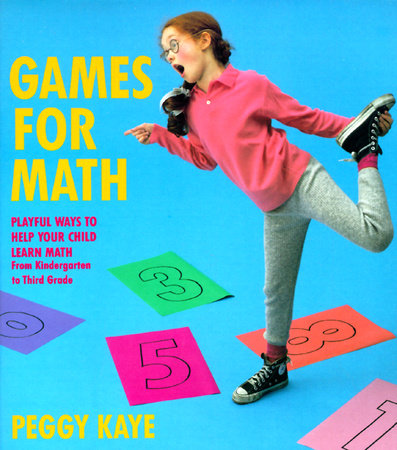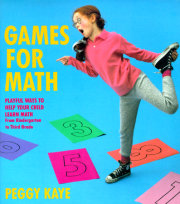I N T R O D U C T I O N How to Use This Book Games for Math has three parts. Parents of kindergarten children should pick from games in Part One, which are geared to a young child’s brand of logic. For first-graders, you can pick any of the games in Part One and most of the games in Part Two. With second-graders you can play any game in the book without exception. Each game is, in any case, labeled with suggested grade levels, so you needn’t worry about remembering which part is for which grade. Of course, you shouldn’t regard grade levels as a rigid rule. You have to observe how your particular child fares with a given game. Sometimes that you’ll notice a game seems too easy. No problem. Playing a certain number of easy games is a good idea. Games that are too easy give children a chance to review. Children can make big educational gains by going over work they already know. Obviously, though, if you play too many easy games your child will lose interest. Pick a harder game, then, and see how the child reacts. If your child makes a lot of errors, you’ll know the game is too hard, which is no good. Children learn more math and enjoy math more if they play games that are a little too easy rather than a little too hard. So if you end up with a game that’s too hard, gently switch to something easier.
You don’t have to play the games in any particular order. With grade levels in mind you can skim through the book and start where you want. You might play multiplication games before adding games, or geometry games before counting games—it makes no difference. One point does make a difference, however. You must pick games that seem like fun for you and your child. Refrain from games that don’t entertain. I’ve tried to include activities for all tastes—board games, card games, puzzles, even collages and cooking instructions—so it should be easy to find something that appeals.
The games are suited for every time schedule. There are talking games that take no preparation and can be played in a minute or two while you set the table or ride in a car. Other games take as long as fifteen minutes to get ready and half an hour to play. The game preparations are do-it-yourself, but the doing isn’t hard. The equipment you’ll need for most of these games is paper, pencil, index cards, paper clips, pennies, playing cards, dice, and an occasional bean or noodle.
Games for Math has some limitations. The book doesn’t pretend to offer a complete math curriculum. Important topics like fractions aren’t broached. Numerical estimation and certain other topics are addressed only in passing. Which is to say, the book is designed to help you back up a school math curriculum, but it can’t replace that curriculum. Nor can the book tell you how to do your own private tutoring of a child who is floundering (though if your child does receive private instruction, at school or at home, you might want to discuss math games with the tutor and pick activities to reinforce what the tutor is doing).
Should you play games with your child every day or once a month? Should you play during the school vacations and not during the school year? Should you play a favorite game over and over or try new games each time you play? Should you read all the games in the book or skim around until one of the games catches your fancy? Should you avoid a game that didn’t pan out or try it again in a week, a month, or a year? The answer to these questions is: whatever seems agreeable to you and your child is what you should do.
The best advice on how you should play these games is—relax. Relaxing might mean changing the rules at the spur of the moment to better suit your child’s personality. It might mean forgetting about a game halfway through because it stopped being fun. Relaxing means not worrying if your child seems to have trouble playing a particular game. Remember how it was when your child learned to walk? You weren’t concerned about stumbles along the way. You weren’t concerned because you knew that soon enough the child would not only walk, but run. You didn’t pressure your child to take one more step, and you didn’t worry if the baby next door walked a bit sooner than your baby. You patiently waited until your child was ready. Just so with math. Give the child a chance. Don’t worry about the stumbles. Your child will learn to add and subtract and do all the other procedures in good time. Relax—all will be well.
You should remember that your child, too, has worries, which may be greater even than your own parental anxieties. First off, there’s the issue of competition. Children find competitive games exciting, but also anxiety-provoking. Children want to win and are rarely good sports when they lose. Losing is painful. For some children, especially younger children, it is too painful, making competitive games a miserable experience for all involved. Does this mean you should avoid all competitive games or rig games to guarantee your child victory? In some few cases, yes. Generally, though, if you’re sensitive to your child’s tolerance for losing and stay within his frustration limits, things will go nicely. Occasionally you might rig a game in your child’s favor, but not all the time.
Even during noncompetitive games—where winning isn’t the goal—your child may get upset when he makes mistakes. That’s because a child wants to perform perfectly in front of the most important people in his life, his mother and father. If your child finds mistakes hard to take, a little humor can be reassuring. Try saying, “It’s OK to make mistakes—even I, your wonderful, terrific parent, sometimes make huge, jumbo, incredible boo-boos.” Or say, “Thank goodness you made that mistake! If you never made any mistakes, I would never win a game. That wouldn’t be fair.” Or, “Finally, you made a mistake. Unless you make a few mistakes this game gets really boring.”
Try picking out a game. Soon enough you’ll know how your child feels about it. If you’ve given the game a fair chance, and the child frowns, put the game away. A game that’s a drag, a bore, and a dud isn’t worth wasting time that you and your child share. Somewhere on another page is a game that will cause a smile. That’s the game for you. Does it call for rolling dice or picking cards of jumping around the room? Fine, do it. You and your child will enjoy each other; and your own pleasure will be that much greater, knowing that your child is slowly mastering mathematics.
Copyright © 1988 by Peggy Kaye. All rights reserved. No part of this excerpt may be reproduced or reprinted without permission in writing from the publisher.









